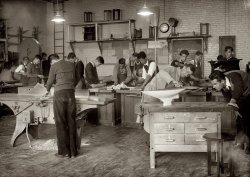
MAY CONTAIN NUTS

Search Shorpy
SHORPY ART

Framed or unframed, desk size to sofa size, printed by us in Arizona and Alabama since 2007. Explore now.
Join and Share
Ad-Free Shorpy
Shorpy is funded by you. Patreon contributors get an ad-free experience.
Learn more.

Recent comments
- +112
- Rear View
- Way in the back --
- Button It Up
- And with an eye on the time ...
- Working in an enclosed ashtray
- Rear View Mirror?
- Tobacco cam
- Basic fact I learned only later in life
- Put a Lid on it!
- Pinstripes in the Tower
- Sound enhancement
- 3438 in '38
- Second Career
- Their days are numbered
- Only the Sensor
- Train control mechanism
- Rarest of the Rare?? & Classy 3400 Class
- Control Mechanism
- Those standpipes
- Wrenches
- International D-40 I believe
- Job prospects
- You had me at Train
- Land of the free
- Broad-Exchange Bldg
- Parking innovation
- The old block
- "Peck turned a sweet propeller"
- National Bank Building
Member Photos
The Shorpy
Printporium
Printporium
Search Shorpy
Search results -- 30 results per page
- Ice Dealer: 1941
- ... small wagon with the cage-enclosed merry-go-round for the kids. All going door to door offering their goods and services.
The leaping ... Posted by Dave - 06/25/2018 - 10:00am -
![Ice Dealer: 1941 December 1941. "Ice man. New York City." Medium format negative by Arthur Rothstein for the Farm Security Administration. View full size.
Alas, Doomed James"Tell of Seeing James Go to Doom in Flight Fight," the headlines scream.
Who among the Shorpyite sleuths might be able to pin down the date of the photograph from this tantalizing little clue?
(Flair enough; the flocus on these phlotographs are always a tad flidgety.)
PushcartsThe ice dealer was one of the few who plied the streets with their carts. The others were gathered into centers where they sold their wares. Mayor LaGuardia housed them in the Essex Street Market. The first pushcarts appeared on Hester Street in 1886. There were 10,000 street vendors at one time in NYC.
Grandpa did thisMy grandfather Anthony Sabbatini was the iceman in East New York, Brooklyn. Known as "Tony the Iceman" for years until he finally got a job with Railway Express, sort of like UPS of the 1930s. He was a strong stocky guy who must have climbed a million stairs delivering ice and packages. A hard life no matter how you look at it.
I still remember:Growing up on Belmont Avenue in the Bronx in the 1940s and seeing the ice man, the coal delivery trucks, the horse-drawn vegetable wagon, and the small wagon with the cage-enclosed merry-go-round for the kids. All going door to door offering their goods and services.
The leaping ramgives away the 1936 Dodge on the right. A universally recognized trademark, it is still in use both in name and image 82 years later.
Maybe ...If those are old newspapers that he's using for wrapping, could the headline refer to the sinking of the Reuben James?
[Yes, and he went down at Madison Square Garden. - Dave]
Looks like the placeWest 18th Street between Ninth and 10th avenues. A most unusual building in a neighborhood rapidly redeveloping itself. Old maps label this a gasholder house for the Manhattan Gas Company. It shows up on the earliest map I could find of this area, 1854, and could be a good deal older than that. An incredible survivor.
(The Gallery, Arthur Rothstein, NYC)](https://www.shorpy.com/files/images/SHORPY-8b16091a.thumbnail.jpg)
- Kid Creole: 1940
- ... Administration. View full size.
(The Gallery, Kids, M.P. Wolcott, Rural America) ... Posted by Dave - 02/03/2017 - 6:30pm -
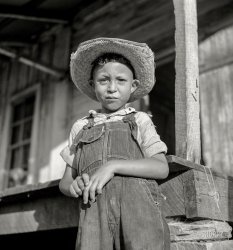
- Toy Story: 1943
- ... View full size.
(The Gallery, D.C., Esther Bubley, Kids) ... Posted by Dave - 03/31/2017 - 11:04am -
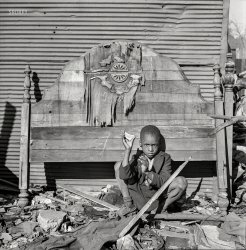
- The Auscultation: 1939
- ... View full size.
(The Gallery, John Vachon, Kids, Medicine) ... Posted by Dave - 10/15/2019 - 12:48pm -
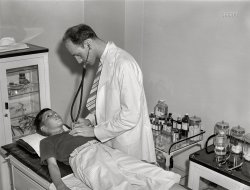
- Centennial
- ... Ship Sighting the Enemy"
(ShorpyBlog, Member Gallery, Kids) ... Posted by John C - 07/21/2007 - 8:31am -
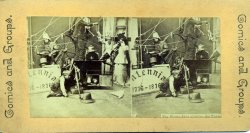
- Meet Muttzie: 1942
- ... comics I grew up reading. The old jalopie is full of kids with more outside the vehicle and hanging on. I can readily pick out the ... Posted by Dave - 05/18/2019 - 12:28pm -
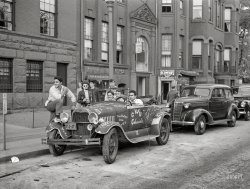
- Party Time: 1954
- ... Earl Theisen for Look magazine. View full size.
(Kids, LOOK, TV) ... Posted by Dave - 06/13/2018 - 1:23pm -
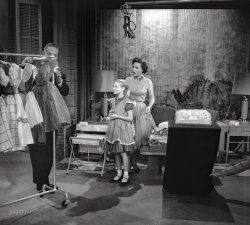
- Park Avenue Noir: 1958
- ... now... "Every light in the building is on! Do you kids have any idea of how expensive electricity is?"
Too Lazy to Sweep ... Posted by Dave - 08/23/2013 - 12:13pm -
![Park Avenue Noir: 1958 January 3, 1958. "Seagram Building. Night view, Park Avenue." Large-format acetate negative by Samuel H. Gottscho. View full size.
A less dominant viewRecessing the Seagram Building behind a plaza was an innovative idea at the time but now means that it doesn't particularly dominate the Park Avenue streetscape. If you go a block or two north and look to the south, similar to the view in this photo, you'll barely see the Seagram Building at all as most of it is blocked by its next door neighbor at 399 Park Avenue. That 41-story building, which opened in 1961, is built out to the sidewalk line and hence much more visible. Fortunately, the Seagram Building is more visible from the south, as its southerly neighbor at 345 Park is also recessed from the sidewalk line. That building was a decade in the future at the time of this photo, and some older buildings are seen on what became its site.
To the Seagram Building's right, further south on Park, the towers of the Waldorf-Astoria are in plain sight. Like the Seagram Building, the Waldorf has had remarkably few exterior changes over the decades. While I'm not positive, I believe that the building under construction to the left of the Seagram Building is 750 Third Avenue. It was one of the first of the big office buildings to sprout up along Third Avenue following the demolition of the Third Avenue El in 1955. While the loss of the El was a major setback to the city's transportation infrastructure, one which has never been (and probably never will be) remedied, it did make formerly down-at-the-heels Third Avenue a desirable location for businesses.
After doing a bit of research it's apparent that the photo's date is incorrect. It had not snowed for at least two weeks prior to January 3, 1958 (yes, old weather records are easily found online), and any snow that had fallen earlier in December would have melted in the unseasonably warm weather at year's end and on New Year's Day.
A bigger issue is the construction site just to the north of the Seagram Building, where 399 Park Avenue now stands. Construction on 399 Park Avenue did not begin until 1959. It may be that the developers had cleared the lot by the beginning of 1958, and erected a fence around the property, but did not start actual construction for another year. I haven't had any luck trying to research this situation online.
MoodyCue up Park Avenue Beat (Perry Mason Theme Song)
I can hear my father now..."Every light in the building is on! Do you kids have any idea of how expensive electricity is?"
Too Lazy to Sweep off the SnowI guess that, since the invention of the automobile, there have always been those people that can't be bothered to fully remove the snow from their car. At least they cleared the windows. That appears to be a 1953 or 1954 Ford.
The car that looks alarmingly like it is going the wrong way down the road at a quick glance, due to the bright tail lights and front-end-shaped back end is a 1956 or 1957 Ford. Not sure about the others. I'm sure a car expert will show up to ID those.
[1957. -tterrace]
We Try HarderThe snow laden automobile in the foreground was a rented car. The NY State license plate 2Z1949 that year was yellow numerals on a black background. The colors were reversed every so often, The letter Z indicated a rented car. That practice ended in 1993 when a tourist drove a rented car out of an airport and was followed by armed thieves who then robbed, shot and killed him. Arriving travelers were chosen because they usually carried large sums of money and jewelry.
CarsThe snow-covered Ford looks like a 1954; the 1953s had different tailights. The car next to the 1957 Ford is a 1955 Plymouth. The car next to it is hard to make out but may be a 1955-56 Oldsmobile.
(The Gallery, Cars, Trucks, Buses, Gottscho-Schleisner, NYC)](https://www.shorpy.com/files/images/SHORPY_5a16908u.thumbnail.jpg)
- Downhill Slider: 1944
- ... of War Information. View full size.
(The Gallery, Kids, NYC, Richard Boyer) ... Posted by Dave - 05/27/2017 - 10:28am -
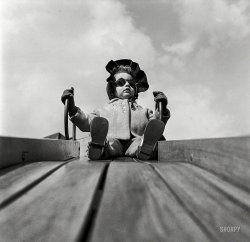
- A Model Student: 1940
- ... immaculately clean artists. Whenever I and/or my kids used paints, clay or other mediums, we had to wear smocks, hats and ... Posted by Dave - 07/27/2012 - 4:47pm -
![A Model Student: 1940 Circa 1940. "Montgomery High School, Maryland." Some of these students also seen here. National Photo Company Collection film negative. View full size.
Drawn from lifeReminds me of an art class I took my sophomore year in college! Except the guy was nekkid.
Neat ArtistsThese are very well-dressed, immaculately clean artists. Whenever I and/or my kids used paints, clay or other mediums, we had to wear smocks, hats and raincoats over our clothing to avoid ruining our good clothes. Apparently we were way too sloppy to be "creative."
Wrong ModelThe young lady on the far right ought to be the model. She has a classic profile and hair for the period AND~ she has on delicious high heels, and well turned ankles. Be still my beating heart!
[Promise us it's just your heart. - Dave]
Herringbone and clayNote the inverted pleats on the boy's herringbone jacket: kind of unusual tailoring for men's clothes, no? Also: he appears to be sculpting a copy of one of Rodin's "Burghers of Calais". That's an ambitious art class!
(The Gallery, Education, Schools, Natl Photo)](https://www.shorpy.com/files/images/28271u.thumbnail.jpg)
- Pork Shrinkage: 1937
- ... many months. Now that's a ham!
No wonder that today's kids are listening to their rap music and texting on their tweeters and wearing ... Posted by Dave - 08/28/2012 - 1:42pm -
![Pork Shrinkage: 1937 1937. College Park, Maryland. "Hams. From time to time the hams are taken from the incubator by Mr. Carroll and weighed to check the shrinkage caused during the aging process." Harris & Ewing Collection glass negative. View full size.
Speeding up Nature
Photo captions, Washington Post, Oct 30, 1937
New Curing Method at University of Maryland
Experimental Station Ages Hams in Six Weeks
Speeding up Nature. In co-operation with the U.S. Department of Agriculture, Mr. F.D. Carroll of the University of Maryland, shows how the ham is rubbed in a mixture of salt, brown sugar and saltpeter before it is smoked. Three days are allowed for the curing of each pound of ham.
A specially constructed incubator maintains temperature from 107 to 125 degrees F. The hams are set in the incubator and the thermostat, controlling the heat, is set at the required temperature. Using this process it is no longer necessary to age hams a year or more to obtain that ..
.. sharp, pungent, cheesy flavor in the lean meat so characteristic of the Southern style ham. From time to time the hams are taken out of the incubator to check for shrinkage that results during the aging process. Depending upon the weight of the ham, the curing method ..
..seldom extends over ten weeks. In the photo above Mr. Carroll has just removed the finished product. Miss Ruby Bresnahan, coed at the university is permitted to inhale the aroma from the quickly aged, fully cured ham.
The aroma of spoilageA "pungent, cheesy flavor" in the meat?
That's usually when I toss the stuff in the trash.
Minion of SatanThat's what this Mr. Carroll is. The decline of our great American culture began when a bunch of pointy-head university people sold us the bill of goods that three days per pound was ample curing time for a ham. Oh, it looked like a ham and it smelled like a ham, but it didn't TASTE like a ham. Mister Carroll might have been able to fool the young college folks, but now there's been three or four generations who have never had the exquisite pleasure of tasting a ham that has been coated with black pepper (to keep the bugs away) put in a burlap sack and hung in a curing barn for many months. Now that's a ham!
No wonder that today's kids are listening to their rap music and texting on their tweeters and wearing their baggy pants; they've never tasted a real ham.
Where's RubyDid Ms. Bresnahan finally come to her senses and leave?
Ham It UpNot one, but two ham shots. There is something about these two that crack me up every time I look at them.
Notice—Any chance we can read that notice in the blackboard? I see "Anyone ... will be ... [very important underlined word]!" I am intrigued.
(The Gallery, Harris + Ewing)](https://www.shorpy.com/files/images/29232a.thumbnail.jpg)
- The Hill: 1938
- ... across the street to benefit both sides, and are those kids choosing not to be photographed?
Long Gone My best guess is that we ... Posted by Dave - 09/28/2020 - 8:21pm -
![The Hill: 1938 July 1938. "Houses on slum section 'The Hill.' Pittsburgh, Pennsylvania." 35mm nitrate negative by Arthur Rothstein for the Farm Security Administration. View full size.
Woman in white heelsI suppose one learns the best way to stand on a slope when one lives on a hill. This young lady has adopted a stance where she leans one shoulder against the wall, while angling her legs away from the wall, like a buttress. I imagine this allows her to avoid leaning backwards against the slope.
What great co-operationto allow clotheslines across the street to benefit both sides, and are those kids choosing not to be photographed?
Long GoneMy best guess is that we are in the area that was cleared for the new Civic Arena in the 1950s. The street (alley?) we're looking down runs south down the hill, toward downtown, and then bends slightly to our right and there were a few streets that bent slightly like this. The Civic Arena is gone now too and may be redeveloped into residential housing and retail spaces.
Object in the upper leftDoes anyone have any idea what sort of device that collection of metal looking things is in the upper left? Antenna?
[Bean vines. - Dave]
One man's slum is another man's neighborhoodI have read that it was still a decent working-class neighborhood in the 1930s, but declined thereafter. In the summer of 1956, some 1,300 structures were razed, displacing 8,000 residents, most of them Black. The Civic Arena and acres of parking rose of the site, making possible a concert by the Beatles (1963) and hockey by Mario Lemieux (1984-2006).
(The Gallery, Arthur Rothstein, Pittsburgh)](https://www.shorpy.com/files/images/SHORPY-8a09987a.thumbnail.jpg)
- The Brothers: 189x
- ... View full size.
(The Gallery, Bell Studio, D.C., Kids, Portraits) ... Posted by Dave - 06/12/2017 - 5:57am -
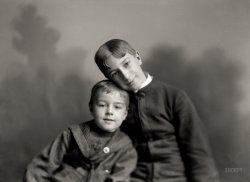
- Wonder-Go-Round
- ... spin! View full size
(ShorpyBlog, Member Gallery, Kids) ... Posted by Weezride - 09/20/2011 - 10:18pm -
- Semmes City: 1926
- ... Raymond Street in Bethesda, Maryland, with his wife, four kids and mother-in-law.
1940 sees him as a real estate salesman in Miami ... Posted by Dave - 06/22/2018 - 11:28am -
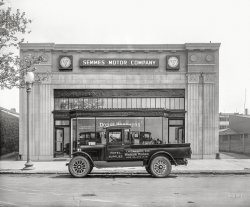
- Queen of the Road: 1963
- ... cooking because she had the hard job...knowing what the kids were doing and where they were doing it.
Takes me back! Reminds me ... Posted by delworthio - 01/06/2009 - 3:35pm -
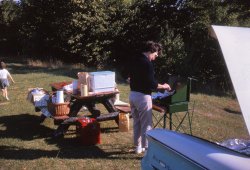
- Nature & Nurture: 1943
- ... View full size.
(The Gallery, Camping, Gordon Parks, Kids) ... Posted by Dave - 03/27/2019 - 1:29pm -
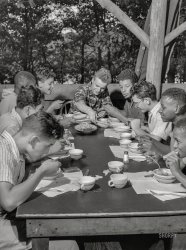
- Canal Street: 1907
- ... now there's an appealing idea! "Those are screams of joy, kids -- no worries!" My mother recalls her 1930s visits to a dentist named Dr. ... Posted by Dave - 10/15/2020 - 10:50am -
![Canal Street: 1907 New Orleans circa 1907. "Canal Street." Center stage: A Streetcar Named Prytania. Composite image made from two 8x10 inch glass negatives. View full size.
Expensive healthcareIt is probably no coincidence that a Loan Office is in the same building as the National Dental Parlors.
Tooth-hurty1907 dentistry on an industrial scale ... now there's an appealing idea! "Those are screams of joy, kids -- no worries!" My mother recalls her 1930s visits to a dentist named Dr. Carpenter. Guess what sort of tools he used?
Details about the photoOf the five tracks in this view, only the two outer tracks were dual gauge. Actually, you can see it, just vaguely. It's the right-hand rail that was dual, and it looks like the railhead is wider. That's the effect of the double right-hand railheads next to each other (with just wheel flange clearance between them).
We can date the photo to no later than 1904. In that year, by Louisiana law, all vestibules had to be enclosed. I suspect it dates from 1900-1904.
[It was taken the same day as this view, whose negative is marked with a copyright date of 1907. - Dave]
The car with the Prytania clerestory sign was presumably assigned usually to that route, but is not at that moment on that route. A Prytania car would not be on that track. Note the Special sign hanging from the dash. I believe the car is on some kind of special assignment, perhaps a charter.
A Streetcar Named PrytaniaAs cool a photo as I've seen in a long time. Thank you, Dave
Drip - Drip - DripEarly streetcars and interurbans did not have sealed wheel and axle bearings. The result was that lubricating oil leaked out onto the pavement. You can readily see in these two photos which tracks were the busiest. San Francisco's Market Street had four streetcar tracks, and was known colloquially as "The Roar of the Four".
(The Gallery, DPC, New Orleans, Streetcars)](https://www.shorpy.com/files/images/SHORPY-Canal_Street_1.thumbnail.jpg)
- Looking at the Pictures: 1957
- ... yours, aenthal: the family, the house details, the school kids, the cars. When my own mom (5 children) got all dressed up to go out with ... Posted by aenthal - 05/26/2017 - 7:13pm -
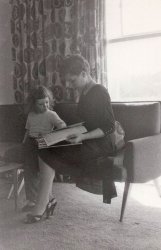
- Of Muskrats and Men: 1941
- ... Administration. View full size.
(The Gallery, Kids, M.P. Wolcott, Small Towns) ... Posted by Dave - 07/24/2019 - 2:28pm -
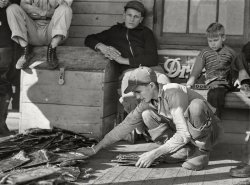
- Hit and Miss: 1941
- ... to be a lost experience. Now no one goes around getting up kids from the neighborhood to play baseball (or a dirt clod fight, or ... Posted by Dave - 06/22/2018 - 8:50pm -
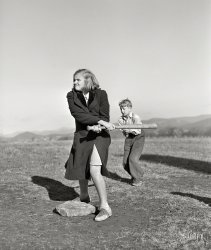
- We’re Blasé: 1941
- ... View full size.
(The Gallery, Arthur Rothstein, Kids) ... Posted by Dave - 06/24/2018 - 5:56pm -
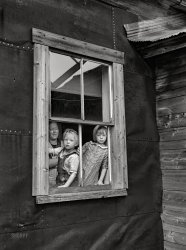
- Violet Mae Phillips - Spring 1934
- ... to burn down the house with everyone in it. The kids came out to confront him and it ended with Violet dead and George spending ... Posted by TK42ONE - 05/18/2007 - 5:45pm -
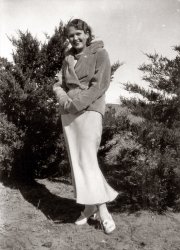
- Hopalong Bunny: 1957
- ... Archive. View full size.
(Columbus, Ga., Easter, Kids, News Photo Archive) ... Posted by Dave - 04/16/2017 - 1:28pm -
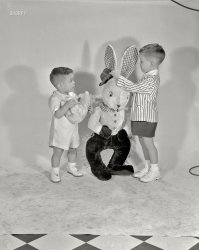
- Last Run: 1925
- ... the poles, throwing on their clothes as they did so. The kids came running, yelping, from everywhere. Driver D. Dwyer mounted an old ... of the engine house dropped and they were off, bellowing kids and barking dogs in their wake. This was the life. Movie men were ... Posted by Dave - 09/13/2011 - 12:14pm -
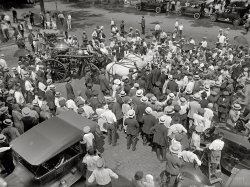
- Tisket & Tasket: 1940
- ... Administration. View full size.
(The Gallery, Kids, M.P. Wolcott) ... Posted by Dave - 06/03/2019 - 9:29am -
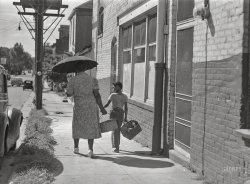
- DRUGS SODA: 1939
- ... bike rack in the prime parking location to lure innocent kids in for their daily DRUG and SODA fixes? ... Probably sold candy cigarettes ... Posted by Dave - 01/10/2018 - 10:39pm -
![DRUGS SODA: 1939 October 1939. "Stores on main street (G Avenue). Grundy Center, Iowa." Photo by Arthur Rothstein for the Farm Security Administration. View full size.
That Corner TowerWould love to see the structural details for that wonderful corner tower.
Agree: probably structural steel behind that masonry, but just how. Nifty what engineers and arkies were able to conjure up before computers came along, just using a K&E slide rule.
Roof blown off?That must have been some party...
MaintenanceRegarding the demise of not only the dunce cap on the corner feature, but the false fronts on two sides of the building, I'm guessing that those features needed roofing and tuckpointing, and perhaps also a bit of carpentry work when the wood underneath rooted. Presented with a quote for repairs, and a quote for removal, the owner made a simple choice.
I'm guessing that round tower is also tied in with the same structural steel that allows the building to have those wide store windows.
Vehicle ID pleaseWhat model of car is the one parked right out front, with the Grundy National Bank awning right above it?
Love it.
[1939 Ford Tudor Sedan. -tterrace]
Thanks! And thank you to Dave and tterrace for posting all these great images!
Happy New Year to all of ShorpyLand!
OrielThe name for the corner tower / feature. Specifically, a corner oriel. An oriel window is a bay window that does not extend all the way to the ground.
The Pusher ManA cobbled-together wooden bike rack in the prime parking location to lure innocent kids in for their daily DRUG and SODA fixes? ... Probably sold candy cigarettes too!
(The Gallery, Arthur Rothstein, Small Towns, Stores & Markets)](https://www.shorpy.com/files/images/SHORPY-8b19076a.thumbnail.jpg)
- Career Girls: 1941
- ... full size.
(The Gallery, Factories, Jack Delano, Kids) ... Posted by Dave - 11/29/2018 - 11:45am -
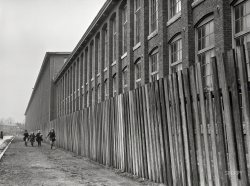
- A Tall Order: 1937
- ... Mr. Mel's comment got me to thinking about the soda pop we kids would get from those ubiquitous Coke boxes. I recall, on a hot summer day, ... Posted by Dave - 08/22/2012 - 9:18pm -
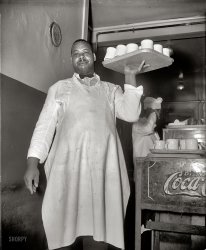
- Shop Class: 1939
- ... yearbook staff and one for drafting. They didn't name the kids in the woodshop photo but the guy in the front with his back to the camera ... Posted by Dave - 09/11/2011 - 10:41am -
